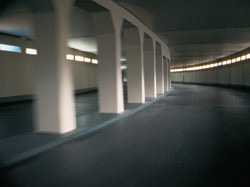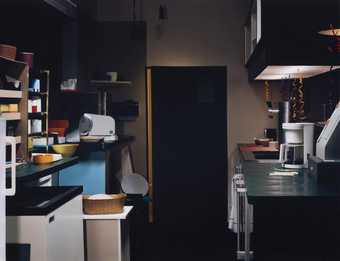
Thomas Demand Tunnel 1999
Consider what it is like to travel through an underpass, such as you might find in any city in the western world. It is an experience that most of us have had, at some time or another. Even if we have not, it is not difficult to imagine. For we all carry around with us a mental databank of generic images of the world that surrounds us, fed by popular culture and the mass media as much as by direct experience. It is into this archive of collective recognition that Thomas Demand taps with his still photographs and with this, his first film, Tunnell (1988-9, 16mm colour film).
Tunnel is intended to evoke the idea or the memory of such a journey, rather than to simulate the experience of any actual event. It is closer in feeling to the images that form in the mind while dreaming, or when thinking about what it might be like to travel through an underpass, for instance. The audience is taken on a succession of endlessly repeated drive-throughs of a strangely familiar yet unidentified place, an archetypal, entirely non-specific tunnel. It could be any tunnel. One does not need to have been there to feel that one knows it well. Some might be reminded of a fateful night in Paris, but Demand is careful not to limit readings of the work by linking it to any one interpretation or event. The absence of any characters, obvious narrative, or action, invites the viewer to engage in a process of speculation and personal identification with the work.
In fact, Tunnel shows not a real underpass but a large-scale model, constructed by the artist, according to his established practice, out of ephemeral materials like paper and cardboard and then photographed, or in this case filmed, using a special effects camera. The soundtrack too is entirely artificial, computer-generated to suggest the movement of a vehicle through the tunnel rather than its actual sound.
Despite adopting some of the tools of the cinema, Demand describes his film as 'more an animated still image than a cinematographic undertaking'. His interest lies chiefly in the formal qualities of the piece, which he relates to both musical composition and minimal structures. Thus, although the film can be considered as a succession of evenly spaced still images, these images are tightly choreographed into an overall structure comprising several slightly different sequences. In each sequence the artist has introduced variations in, for example, the speed of the camera, its direction and angle, and the length of the dark passages between each drive-through.
'He came to a place where he already was' [fn]'Illuc ergo venit ubi erat', Augustinus (Saint Augustine, 354-430 A.D.)[/fn]
The way in which Demand has chosen to display his film Tunnel relates it closely to the still photographs for which he is chiefly known. The thick perspex projection screen, standing just proud of the wall, gives the film the same permanent, object quality, as his photographs, which occupy a realm somewhere between two dimensions and sculpture. Like a number of his contemporaries working with photography, Demand is fascinated by the nature of perception and the way in which media-generated images structure our experience of the world, to the point where they become more real than reality itself. As one critic has described it, in viewing Demand's work, 'you watch yourself watching'[fn]Joshua Decter, in Thomas Demand, exh. cat., Galerie de I'ancienne paste, Le Channel, Calais/Centre d'art contemporain de Vassiviere en Limousin, 1996[/fn]. The work takes for granted the by now commonplace assertion that photography (and film) can no longer be relied upon to act as a true document of the outside world.
Although at first sight Demand's photographs appear to depict real places, primarily modernist urban structures and interiors, the artist quite literally takes the illusion apart at the seams by making no attempt to disguise the joins and folds in the paper models which are the actual subjects of his photographs. It is worth noting that rather than using his camera to document a completed model from a particular viewpoint, Demand first sets up the camera in a fixed position and then builds the model in front of it, constantly checking through the lens as he works. This allows him to adjust the details and perspective of the actual model to meet his compositional needs, a process directly inverse to the digital manipulation that is now common practice in much photography.
The uneasy familiarity of place which pervades Tunnel, that uncanny sense of 'having been here before', also characterises Demand's output in general. The sources for his works lie as much in memory, often of a collective, near-subconscious nature, as in specific events or images. That said, he frequently bases them on pre-existing photographs, culled from newspapers and books, of locations which though seemingly banal are in fact charged with a sometimes troubling historical significance.[fn]Thus one discovers that particular images reference, for example, the bunker in which an attempt was made to kill Hitler, an office at the ex-Stasi headquarters in East Berlin, ransacked by people looking for their secret files, or the barn which Jackson Pollock used as a studio.[/fn] As with the film Tunnel, the deliberately vague titles of his photographs - Room, Office, Barn - and the absence of any figures or obvious narrative; invite the audience, like actors stepping onto an empty filmset, to project their own stories onto these blank yet evocative images.
Text written by Michela Parkin
Biography
Born 1964. Lives and works in Berlin. 1989-92 Kunstakademie, Düsseldorf. 1993-94 Goldsmiths' College, London.

